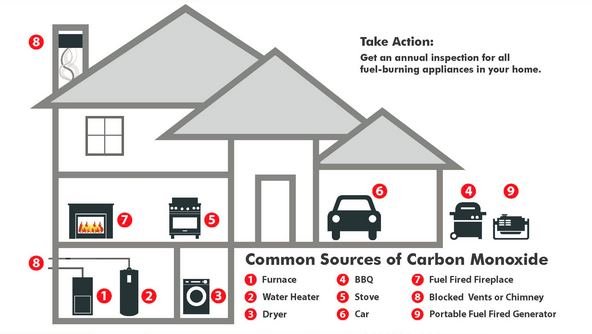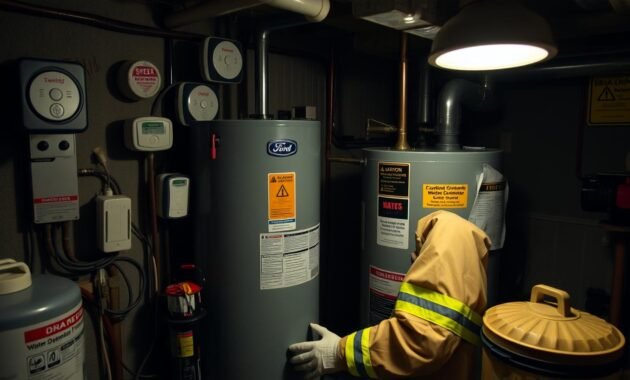I’ve found a hidden danger in many homes – carbon monoxide from gas water heaters. These appliances can turn deadly if not watched closely. It’s important to know about the risks and take action.
Think of an invisible, odorless gas quietly spreading in your home. It’s a threat to your family’s health. Tank-style gas water heaters can leak dangerous carbon monoxide if not kept in good shape. Knowing this can save your loved ones from harm.
Read also: Symptoms of Gas Leak from Water Heater

Understanding Water Heater Carbon Monoxide Risks
Gas water heaters are key for hot water in homes. But, they can be risky if not kept in good shape. It’s vital to stop carbon monoxide for those who use these appliances every day.
Read also: Bradford White Water Heater Model Numbers
Carbon monoxide happens when fuel doesn’t burn right in your water heater. This gas is harmful and can come from bad installation or broken equipment. It’s a big risk for your family’s health.
How Carbon Monoxide Forms in Water Heaters
Carbon monoxide forms when:
- There’s not enough oxygen for fuel to burn fully
- Blocked exhaust vents stop gas from leaving
- Damaged gas lines cause fuel to flow unevenly
- Bad burner parts make burning less efficient
Common Sources of Carbon Monoxide Leaks
Many things can lead to carbon monoxide risks in water heaters:
| Leak Source | Potential Risk |
|---|---|
| Cracked Heat Exchanger | High Carbon Monoxide Release |
| Improperly Sized Venting | Gas Buildup |
| Rusted Connections | Potential Gas Escape |
The Science Behind Gas Water Heater Operation
Gas water heaters work by burning fuel precisely. A metal baffle helps transfer heat well and sends exhaust gases safely. Keeping them installed right and maintained is essential to avoid gas leaks.
Knowing these risks and acting early can keep homeowners safe from carbon monoxide dangers in their water heaters.
Signs Your Water Heater is Leaking Carbon Monoxide
Finding carbon monoxide from a water heater is hard because it’s invisible and has no smell. Only gas and oil-powered water heaters can be risky. So, knowing the signs of a carbon monoxide leak is very important.
Some visual signs that might mean there’s a carbon monoxide problem include:
- Yellow-tinted burner flames
- Moist air around the draft hood
- Condensation or corrosion on water heater top
- Soot residue near the unit
- Slightly melted plastic around inlet and outlet pipes
Signs of carbon monoxide poisoning can show up fast. Symptoms include:
- Persistent headaches
- Dizziness
- Weakness
- Nausea
- Chest pain
- Confusion
I suggest putting carbon monoxide detectors near your water heater and on every floor. These devices can warn you of dangerous gas levels. They alert you faster at higher levels. Early detection is key to avoiding health risks.
Experts like HVAC technicians and home inspectors can find and fix carbon monoxide issues. They make sure your water heater works safely and well.
The Silent Danger: Health Impacts of Carbon Monoxide Exposure
Carbon monoxide poisoning is a serious health risk that can happen without warning. Every year, over 100,000 people visit emergency departments in the U.S. due to carbon monoxide poisoning. Sadly, more than 400 people die from it each year.
Immediate Symptoms and Warning Signs
Spotting carbon monoxide symptoms early can save lives. Exposure to it can cause severe health problems, including:
- Severe headaches
- Dizziness and confusion
- Vomiting chest pain
- Nausea
- Loss of consciousness
Long-term Health Consequences
Long-term exposure to carbon monoxide can cause serious health issues. It binds with hemoglobin better than oxygen, affecting the body’s oxygen transport.
| Potential Long-Term Effects | Impact on Health |
|---|---|
| Neurological Damage | Cognitive impairment and memory loss |
| Cardiovascular Problems | Increased risk of heart disease |
| Respiratory Issues | Reduced lung function |
Risk Factors for Vulnerable Populations
Some groups are more at risk from carbon monoxide poisoning. These include:
- Elderly individuals
- Young children
- People with chronic respiratory conditions
- Individuals with heart disease
If you think you’ve been exposed to carbon monoxide, get out of the area fast. Find fresh air and seek medical help. Quick action is key to protecting your health from this silent threat.
Essential Safety Measures for Gas Water Heaters
Keeping your water heater safe is key to protecting your home and family. Gas heater safety needs regular checks, proper setup, and constant watchfulness.

- Install carbon monoxide detectors near the water heater and on each floor
- Ensure proper ventilation around the water heating unit
- Conduct annual professional inspections
- Check gas line connections regularly
- Keep the surrounding area clear of flammable materials
Important safety rules for gas water heaters include keeping exhaust vents clear and avoiding debris. The Occupational Safety and Health Administration suggests setting water temperatures to 140 degrees Fahrenheit to avoid scalding injuries.
| Safety Measure | Recommended Frequency |
|---|---|
| Professional Inspection | Annually |
| CO Detector Battery Check | Every 6 months |
| Exhaust Vent Cleaning | Twice per year |
| Temperature Valve Testing | Yearly |
Today’s water heaters have advanced safety features like automatic gas shutoff valves and smart leak detection. If your water heater is over 12 years old or looks worn out, it’s time to replace it.
By sticking to these safety tips, you can greatly reduce accident risks. This ensures your gas water heating system works well for years to come.
Carbon Monoxide Detector Installation and Maintenance
Keeping your home safe from carbon monoxide is key. Knowing how to install carbon monoxide alarms is vital. It could save your life.
Gas water heaters and other fuel-burning appliances can be dangerous. It’s important to place carbon monoxide alarms correctly for safety.
Optimal Placement Guidelines
Here are the best places for carbon monoxide detectors:
- Near bedroom areas for quick nighttime alerts
- On every home level, including basement and attic
- Within 10 feet of bedroom doorways
- Close to fuel-burning appliances
- Near attached garage entries
Testing and Replacement Schedule
Keep your carbon monoxide alarm in good shape with these steps:
- Test detectors monthly
- Replace batteries twice yearly
- Replace entire unit every 5-7 years
- Follow manufacturer’s specific maintenance guidelines
Types of CO Detectors Available
There are many carbon monoxide alarm options:
- Battery-operated models for easy DIY installation
- Plug-in detectors with backup battery power
- Hardwired systems connected to home electrical
- Smart detectors with mobile app integration
Quality carbon monoxide detectors are essential for safety. They protect against deadly gas leaks. Keep your family safe by monitoring and maintaining them.
Proper Ventilation Requirements for Water Heaters
Water heater ventilation is key for safety. In the U.S., gas water heaters need proper ventilation. This prevents dangerous carbon monoxide buildup and ensures safe use.
Knowing about water heater ventilation means understanding the different venting methods:
- Atmospheric Venting: Most common method using vertical ducts
- Direct Venting: Uses separate inlet and outlet pipes
- Power Venting: Employs electric fans to enhance exhaust gas removal
When looking at water heater ventilation, several important factors come into play:
- Minimum net free vent area should be 100 square inches
- Metal louver openings require 144 square inches
- Natural gas water heaters need at least two vents
- Vent dimensions should be a minimum of 3 inches
Proper ventilation depends on your water heater’s Btu/hr input rating. Combustion air should come in from the attic. A pipe should be just above floor level. Getting professional certification from groups like the Building Performance Institute ensures your system meets safety standards.
Electric water heaters are simpler. They don’t need venting. They use submerged heating elements controlled by thermostats. This heats water between 120°F and 140°F, making them easy for homeowners to use.
Regular Maintenance: Your First Line of Defense
Keeping your home safe from carbon monoxide starts with regular water heater care. As a homeowner, I’ve found that keeping up with maintenance can stop dangerous situations. It also helps your gas water heater last longer.
It’s key to check your water heater often to spot problems early. Getting your gas heater checked by a pro can catch signs of carbon monoxide risks.
Annual Inspection Checklist
- Check the pressure relief valve for proper functioning
- Inspect the anode rod for corrosion
- Flush the tank to remove sediment buildup
- Examine all gas connections and seals
- Test the pilot light and burner operation
Professional Service Requirements
While you can do some maintenance yourself, getting a pro to check your water heater is vital. Experts say you should get a yearly check to make sure it’s working right and safely.
DIY Maintenance Tips
- Listen for unusual sounds or knocking
- Check for water leaks around the heater
- Keep the area around the water heater clean and clear
- Inspect visible pipes and connections monthly
- Verify proper ventilation around the unit
Lakeside Heating & Air Conditioning says regular maintenance cuts down carbon monoxide risk. By spending a bit of time and effort, you keep your home and family safe from dangers.
Emergency Response to Carbon Monoxide Leaks

Quick action is key when dealing with carbon monoxide leaks from broken water heaters. Knowing the signs and what to do can prevent serious health risks.
If your carbon monoxide detector goes off or you think there’s a leak, here’s what to do:
- Get everyone out of the house right away
- Make sure all family members are safe
- Call 911 fast
- Don’t go back inside until it’s safe
Emergency responders take carbon monoxide leaks very seriously. Calling 911 gets fire departments and medical units to your place fast. They’ll check the situation and stop any more damage.
| Risk Group | Vulnerability Level |
|---|---|
| Infants | Highest Risk |
| Elderly (65+) | High Risk |
| Pregnant Individuals | High Risk |
| Individuals with Chronic Conditions | High Risk |
After the emergency is handled, call a licensed plumber to check and fix your water heaters. They can prevent more carbon monoxide problems and keep your home safe.
Water Heater Carbon Monoxide Prevention Tips
To keep your home safe from carbon monoxide, you need to take action with your water heater. Natural gas and propane systems need extra care to protect your family. By following some key steps, you can lower the risk of harmful carbon monoxide leaks.
Here are important steps to keep your water heater safe:
- Schedule annual professional inspections for your natural gas or propane water heater
- Install multiple carbon monoxide detectors near heating appliances
- Maintain clear space around your water heater
- Replace water heaters older than 10-12 years
- Check ventilation systems regularly
Regular maintenance is your best defense against carbon monoxide risks. Experts can spot problems early and fix them. They check for:
- Proper combustion air supply
- Sealed connections
- Intact ventilation systems
- Signs of corrosion or damage
I suggest getting top-notch carbon monoxide detectors. Put them near bedrooms and where fuel-burning appliances are. Make sure to test the batteries every three months and replace the whole unit every five to seven years. A little prevention can save lives from these silent but deadly gases.
Learning is key. Teach everyone in your home about carbon monoxide signs and what to do in an emergency. Knowing the risks makes prevention a family effort, not just a technical task.
Read also: Whirlpool Water Heater Age
Conclusion
Water heater carbon monoxide is a silent killer that we must take seriously. The sad stories of families affected by CO poisoning show how vital a heater safety guide is. Knowing the risks and acting early can save lives.
My research showed that carbon monoxide causes over 50% of poisoning deaths in industrial countries. This fact makes water heater safety a top priority for homeowners. Regular checks, maintenance, and carbon monoxide detectors are must-haves.
To avoid carbon monoxide risks, we need a few key steps. I suggest annual water heater checks, keeping flammable materials away, and good ventilation. Energy-efficient water heaters also help by cutting down on CO production. By being aware and careful, we can make our homes safe and cozy.
Knowledge is key in keeping your family safe from water heater carbon monoxide. Small steps can lead to big changes in safety. Stay informed and keep your family safe.


